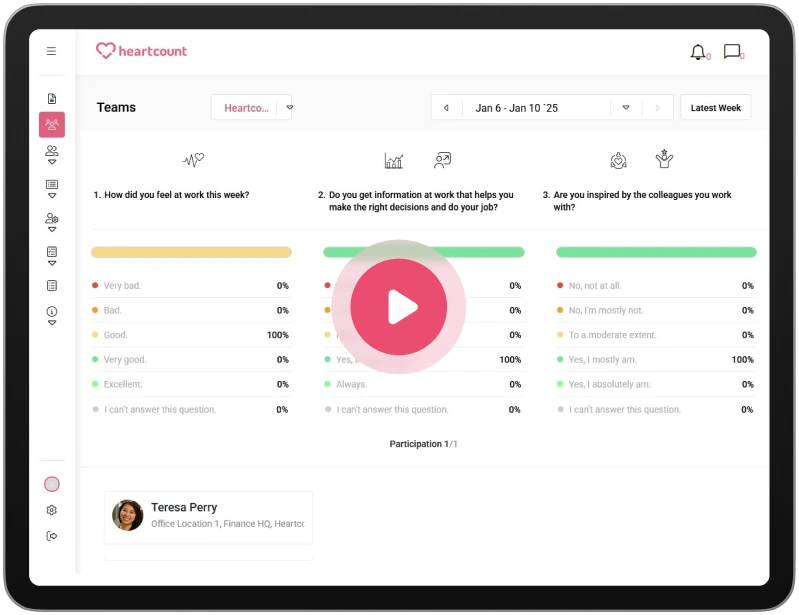Employee Wellbeing: Why It Matters and How to Measure and Improve It in Your Workplace

Employee wellbeing has shifted from a “nice-to-have” to a business-critical priority. In a workplace landscape shaped by hybrid models, rising burnout, and evolving employee expectations, wellbeing is no longer just about perks or programmes. It’s about creating conditions where people can thrive—physically, emotionally, socially, and professionally.
According to a 2024 report by the Chartered Institute of Personnel and Development (CIPD), only 29% of HR professionals believe their organisation takes a strategic approach to employee wellbeing, despite clear links to performance and retention. Meanwhile, Gallup research shows that employees who strongly agree their organisation cares about their wellbeing are 69% less likely to actively search for a new job.
These numbers tell a clear story: improving wellbeing isn’t just good for employees—it’s essential for the bottom line. This guide explores what employee wellbeing really means, why it matters, how to measure it effectively, and what actionable steps you can take to build a workplace where people feel supported and empowered.
HeartCount helps organisations do exactly that with real-time insights, pulse surveys, and manager tools that close the feedback loop. Learn more about how HeartCount supports better workplace cultures through smarter data.
-
1.What Is Employee Wellbeing?
-
2.Why Is Employee Wellbeing Important?
-
3.What Affects Employee Wellbeing in the Workplace?
-
4.How to Measure Employee Wellbeing
-
5.What Are the Five Dimensions of Employee Wellbeing?
-
6.Signs of Poor Employee Wellbeing
-
7.How to Improve Employee Wellbeing: 6 Practical Strategies
-
8.Creating an Employee Wellbeing Plan: Step-by-Step
-
9.How HeartCount Supports Employee Wellbeing
-
10.FAQ: Employee Wellbeing Explained
Employee wellbeing has shifted from a “nice-to-have” to a business-critical priority. In a workplace landscape shaped by hybrid models, rising burnout, and evolving employee expectations, wellbeing is no longer just about perks or programmes. It’s about creating conditions where people can thrive—physically, emotionally, socially, and professionally.
According to a 2024 report by the Chartered Institute of Personnel and Development (CIPD), only 29% of HR professionals believe their organisation takes a strategic approach to employee wellbeing, despite clear links to performance and retention. Meanwhile, Gallup research shows that employees who strongly agree their organisation cares about their wellbeing are 69% less likely to actively search for a new job.
These numbers tell a clear story: improving wellbeing isn’t just good for employees—it’s essential for the bottom line. This guide explores what employee wellbeing really means, why it matters, how to measure it effectively, and what actionable steps you can take to build a workplace where people feel supported and empowered.
HeartCount helps organisations do exactly that with real-time insights, pulse surveys, and manager tools that close the feedback loop. Learn more about how HeartCount supports better workplace cultures through smarter data.
What Is Employee Wellbeing?
Employee wellbeing refers to the overall quality of an employee’s experience at work, encompassing their physical health, mental and emotional state, social connections, financial security, and sense of purpose. It is not a one-off program or perk, but a sustained organisational commitment to creating conditions where staff can thrive. As workforce expectations continue to shift, understanding and investing in wellbeing at work is no longer optional; it is a foundational business need.
While some companies focus narrowly on health benefits or stress-reduction programmes, true employee wellbeing goes far beyond. It integrates daily experience, organisational culture, and leadership behaviour with a long-term view of performance and sustainability.
Key Components of Wellbeing at Work
Employee wellbeing is multi-dimensional. Leading frameworks, including those from CIPD and Deloitte, identify five core domains:
- Physical wellbeing: Support for physical health, fitness, and rest (e.g. healthy workspaces, ergonomic setups, time off, health screenings).
- Mental and emotional wellbeing: Access to psychological support, stress management tools, and a culture of psychological safety.
- Social wellbeing: Relationships with colleagues and a sense of belonging or inclusion within teams.
- Financial wellbeing: Confidence in one’s financial stability, access to fair pay, and support for savings or long-term security.
- Career wellbeing: Opportunities for growth, autonomy, recognition, and alignment between work and personal purpose.
When organisations address all five areas, they create the conditions for healthier, more engaged teams and reduce common risks like burnout or disengagement. This broader view aligns closely with how employee experience is now being managed in real time through people analytics and continuous feedback systems such as employee experience management software.
The Difference Between Wellbeing and Wellness
Although often used interchangeably, wellbeing and wellness are not the same.
Wellness usually refers to personal health practices, like exercising, eating well, and avoiding illness. It is often the focus of workplace wellness programmes, such as gym memberships, smoking cessation, or step-count challenges. Understanding what is employee wellbeing means looking beyond physical health to include mental, emotional, and social factors that influence how people feel and function at work.
Employee wellbeing, by contrast, is more holistic and strategic. It encompasses how employees feel at work, how they experience the culture, and whether they can sustainably perform their roles without sacrificing their health or personal lives.
A company might offer wellness initiatives like healthy snacks or yoga classes, but if employees are overloaded or lack psychological safety, those programmes are unlikely to make a meaningful difference. Addressing wellbeing requires consistent attention to autonomy, workload, team dynamics, and emotional support, all factors central to the digital employee experience.
Why Defining Wellbeing Matters for HR and Management
Without a clear definition, it is easy for companies to reduce employee health and wellbeing to surface-level perks. HR leaders must go beyond isolated initiatives and instead create a shared understanding of what wellbeing means within their context.
For HR and people teams, a precise definition:
- Anchors the strategy to measurable outcomes
- Guides selection of tools such as automated employee pulse check surveys
- Builds the business case for investing in culture, engagement, and retention
For managers, clarity on what employee wellbeing looks like enables better decisions in everyday situations, like balancing workloads, setting expectations, or recognising when someone is starting to disengage. Many early signs of stress or burnout show up subtly, as outlined in the signs of an overworked employee, and can be easy to miss without a structured approach to feedback and check-ins.
Organisations that treat staff wellbeing as a strategic priority tend to see a stronger correlation between engagement and performance. They are also better equipped to respond when sentiment dips.
Why Is Employee Wellbeing Important?
Understanding the importance of employee wellbeing is not just a matter of ethics or culture. It is a strategic imperative that impacts engagement, retention, performance, and overall business outcomes. Companies that prioritise staff wellbeing tend to outperform those that treat it as a secondary concern. Wellbeing at work shapes how people show up, how long they stay, and how well they contribute across every level of the organisation.
Impact on Engagement, Retention, and Performance
Wellbeing is closely tied to employee engagement. When people feel physically safe, mentally supported, and connected to their work, they are more likely to demonstrate focus, commitment, and creativity. The CIPD’s Health and Wellbeing at Work notes that employees with higher wellbeing are significantly more engaged and less likely to take unplanned absences.
In contrast, poor employee health and wellbeing contributes to absenteeism, presenteeism, and higher turnover. Employees experiencing burnout are more likely to disengage, underperform, or leave. Real-time tools, such as HeartCount’s sentiment tracking and burnout alerts, allow managers to spot early signs of strain and address them before they escalate. They also help uncover hidden stressors like recognition gaps or workload imbalance, both of which are common causes of declining morale and engagement.

Business Case: Productivity, Loyalty, and ROI
The business value of investing in employee wellbeing is well-established. According to a Deloitte study, organisations that implement mental health and wellbeing strategies see an average return of £5 for every £1 spent, largely due to improved productivity and reduced turnover.
These gains extend beyond performance. Employees who feel their wellbeing is supported are more loyal, more likely to stay long term, and more inclined to recommend their employer to others. Initiatives that target both mental and physical wellbeing reduce turnover and enhance employer brand. The impact of poor wellbeing on attrition is also reflected in employee turnover trends tied to burnout-heavy roles.
What Employees Expect Today from Employers
Expectations around wellbeing have shifted rapidly. Since the pandemic, employees view support for mental health, flexibility, and emotional safety as basic requirements rather than perks. The American Psychological Association found that 81% of workers say they will prioritise workplaces that support mental wellbeing when considering future roles.
This shift is especially visible among younger employees, who expect more from their managers than task delegation. They look for emotional intelligence, empathy, and a commitment to career growth aligned with personal values. Sentiment data from platforms like HeartCount confirms that wellbeing is strongly tied to how employees perceive leadership, recognition, and workload fairness.
Providing structured support for wellbeing is no longer a competitive differentiator — it is a baseline expectation. The organisations that get it right are the ones that embed wellbeing into daily culture, not just annual surveys or HR policies.
COLLECT
What Affects Employee Wellbeing in the Workplace?
Employee wellbeing is shaped by more than just policies or benefits. Daily interactions, leadership style, team dynamics, and perceived fairness all play a role in how people experience their work. When these factors are consistently misaligned, wellbeing suffers, regardless of how generous a company’s wellness perks may be. Understanding these drivers helps HR and managers not only diagnose issues early but also design environments where people can thrive.
Leadership and Manager Behaviour
Leadership is one of the most influential drivers of employee wellbeing. Managers who are empathetic, communicative, and responsive tend to create teams with higher morale and lower stress levels. On the other hand, poor management practices such as micromanagement, unclear expectations, or lack of support often result in disengagement and elevated turnover risk.
Consistent one-on-one conversations, transparent goal-setting, and active listening are some of the most effective behaviours for improving staff wellbeing. Tools like manager nudging, based on real-time sentiment data, can help team leads respond more quickly to issues affecting staff wellbeing, especially in hybrid teams where direct visibility is limited. This is particularly important in hybrid or distributed teams where visibility into employee experience is often limited.
Workload, Expectations, and Autonomy
Unrealistic deadlines, persistent overtime, and reactive task-switching are major sources of stress. When employees feel they lack control over their workload or schedule, wellbeing declines rapidly. Autonomy has been shown to buffer against stress and increase resilience, even in high-pressure roles.
Balancing accountability with flexibility is key. This includes giving employees input into deadlines, avoiding always-on expectations, and recognising when workloads have become unsustainable. According to the CIPD, workload remains one of the top causes of work-related stress in the UK workplace.
Recognition and Purpose
Recognition and a sense of purpose are foundational to employee wellbeing. When people feel that their efforts are seen and valued, they are more likely to remain engaged and motivated. A lack of appreciation is a common factor in emotional withdrawal and burnout.
Peer-to-peer recognition platforms and frequent manager appreciation help address this issue. Organisations that build recognition into their routines tend to see higher wellbeing scores across both individual contributors and team leads. The principles behind meaningful appreciation are outlined in this article on recognition in the workplace, which explores tactical ways to integrate praise into everyday workflows.
Purpose also matters. Employees who understand how their role connects to wider organisational goals report higher wellbeing and are more likely to stay long term. Line managers play a key role in reinforcing this alignment through regular feedback and strategic context.
Relationships and Team Dynamics
Workplace relationships affect everything from stress levels to job satisfaction. Teams with high levels of trust, mutual respect, and open communication tend to report stronger wellbeing. In contrast, teams marked by tension, exclusion, or poor collaboration often experience disengagement and friction.
This is especially true in cross-functional or hybrid teams where collaboration depends on deliberate communication. Inclusion also plays a critical role. Employees who feel socially or culturally excluded often report lower wellbeing and are more likely to leave. Proactive team-building, psychological safety, and informal rituals help maintain cohesion, even in decentralised environments.
Physical and Mental Health Support
Workplace design, health benefits, and access to mental health support are all visible indicators of how much a company values employee health and wellbeing. Providing ergonomic workstations, healthy meal options, or regular health screenings reinforces a culture of care.
Mental health support is equally important. This includes offering access to counselling, enabling time off for recovery, training managers in mental health awareness, and reducing stigma. Tools like burnout risk alerts or weekly check-ins can help identify problems early. When employees know that support is available and encouraged, they are more likely to seek help and return to a healthy baseline faster.
Career Growth and Development Opportunities
Lack of growth is one of the most consistent drivers of disengagement. Employees who feel stuck or undervalued are more likely to withdraw or leave, especially in competitive job markets. Opportunities for development, including mentoring, skills training, and career path clarity, are strongly linked with long-term motivation and satisfaction.
Career development does not always require a promotion. Stretch projects, learning budgets, or time allocated for personal development can make a measurable difference. These approaches are further explored in this resource on employee development, which outlines effective strategies for building growth into everyday work.
How to Measure Employee Wellbeing
Measuring employee wellbeing requires more than annual surveys or anecdotal check-ins. To create a workplace that truly supports staff wellbeing, organisations need timely, reliable data that captures how employees are doing across multiple dimensions. The right measurement strategy balances both quantitative insights and qualitative feedback, providing HR and managers with a real-time view of what’s working and what needs attention.
Research from CIPD highlights that companies using regular feedback tools such as pulse surveys and real-time analytics are more likely to identify wellbeing risks early and take corrective action, compared to those relying solely on annual engagement surveys (CIPD, 2024). The ability to detect emotional strain and respond in the moment is increasingly seen as a core component of responsible people management.
Surveys, Pulse Checks, and Analytics
Regular employee surveys remain one of the most effective ways to track wellbeing at work. These can include longer engagement surveys conducted annually or quarterly, but pulse surveys are increasingly used to measure sentiment in real time.
Weekly or biweekly pulse checks allow companies to:
- Track changes in mood, energy, and motivation
- Identify early signs of disengagement or burnout
- Surface team-level issues before they escalate
- Benchmark progress against past scores
Platforms like HeartCount make it easy to automate this cadence, using short, targeted questions that employees can respond to quickly. Built-in analytics then identify patterns, flag at-risk individuals or teams, and provide actionable insights to managers. This form of continuous listening is critical for maintaining awareness and momentum in wellbeing strategies.
Wellbeing-focused surveys typically cover themes such as:
- Energy and stress levels
- Perceived fairness and workload
- Manager support and recognition
- Belonging and inclusion
- Work-life balance
Qualitative feedback can be just as valuable. Open-text responses and anonymous comments offer context behind the scores and highlight issues that metrics alone may miss. Anonymous feedback loops are especially effective for creating psychological safety and surfacing concerns early.
Behavioral Signals and Manager Feedback
Beyond surveys, wellbeing can also be inferred through behavioural indicators. Changes in behaviour often reflect shifts in wellbeing before employees explicitly report them. These may include:
- Sudden increases in absenteeism or lateness
- Reduced participation in meetings or collaboration tools
- Missed deadlines or lower productivity
- Signs of withdrawal or irritability
Managers play a crucial role in spotting these patterns. Consistent one-on-ones, informal check-ins, and open communication channels make it easier to notice when someone may be struggling. To make this process more objective and scalable, some organisations use AI-powered tools to surface mood or engagement shifts based on ongoing feedback data.
Manager insights are also critical when interpreting wellbeing trends at the team level. For example, two teams may show identical survey scores but differ dramatically in how managers respond to emerging issues. Integrating data with direct manager input helps create a more accurate and nuanced understanding of staff wellbeing.
Example KPIs for Measuring Wellbeing
To measure the effectiveness of wellbeing strategies, HR teams often track a combination of leading and lagging indicators. Here are common wellbeing-related KPIs used in mid-sized and large organisations:
| KPI | What It Reflects |
| Pulse survey wellbeing score | Self-reported wellbeing sentiment over time |
| Absenteeism rate | Potential stress, illness, or disengagement |
| Turnover or retention rate | Overall satisfaction and long-term commitment |
| Employee Net Promoter Score (eNPS) | Loyalty and perception of the workplace |
| Utilisation of wellbeing benefits | Awareness and adoption of available support options |
| Manager check-in frequency | Consistency of support and early intervention |
| Burnout risk indicators | Predicted emotional strain based on mood trends |
Tracking these metrics allows HR and leadership to shift from reactive to proactive, adjusting initiatives based on real feedback instead of assumptions.
Platforms that support real-time pulse measurement and feedback, like HeartCount, help operationalise this approach. They reduce reporting delays, increase visibility across teams, and enable targeted action at the right time.
What Are the Five Dimensions of Employee Wellbeing?
Employee wellbeing is not one-dimensional. It is shaped by multiple aspects of a person’s experience, both inside and outside the workplace. Leading frameworks, including those from Deloitte and CIPD, often group wellbeing into five key dimensions. When employers understand and address each area, they can build strategies that are balanced, inclusive, and effective over time.
Career Wellbeing
Career wellbeing reflects how fulfilled employees feel in their roles, whether their work aligns with personal ambitions and whether they see opportunities for progression. People are more likely to experience high levels of wellbeing when they use their strengths, feel recognised, and have access to learning and development. Questions or sentiment dips around career fulfilment can become clear through real-time tools like pulse surveys or recognition features that reinforce growth and visibility.
Social Wellbeing
Social wellbeing encompasses trust, cooperation, and a sense of belonging within the team. Healthy workplace relationships and open communication protect against stress and burnout, whereas exclusion or poor collaboration, especially in remote or hybrid setups, can damage morale. Building inclusive routines and psychological safety supports social resilience and engagement.
Financial Wellbeing
Financial wellbeing is about having control over one’s economic life. It includes feeling secure about pay, benefits, and retirement planning, as well as access to tools that support budgeting or savings. Stress over finances is a common distraction, and alleviating this can lead to noticeable performance improvements.
Physical Wellbeing
Physical wellbeing includes physical health, ergonomics, rest, and preventive care. It goes beyond classic wellness programs to include workplace norms, such as encouraging breaks, healthy movement, and access to screenings or fitness tools. Awareness of indicators like fatigue or overwork helps bring physical wellbeing into a broader organisational conversation.
Community Wellbeing
Community wellbeing speaks to the greater purpose employees feel in their work: connection to organisational mission, societal contribution, or pride in shared goals. A key way to enhance this dimension is through peer recognition. The HeartCount feature for employee recognition embeds gratitude into daily interactions, reinforcing that individual contributions matter and strengthening team cohesion.
UNDERSTAND
Signs of Poor Employee Wellbeing
Poor employee wellbeing doesn’t always announce itself loudly. It often shows up gradually, through shifts in behaviour, mood, or performance. If left unaddressed, these signals can lead to burnout, disengagement, absenteeism, and turnover. Identifying early signs across physical, emotional, and behavioural dimensions enables HR teams and managers to take action before deeper issues take hold.
Absenteeism and Presenteeism
A rise in sick days, late arrivals, or unplanned absences can be an indicator that an employee is physically or mentally unwell. Just as concerning is presenteeism, which occurs when employees continue working while unwell and are not functioning at their usual capacity due to stress, fatigue, or health issues. Both patterns reduce productivity and may indicate that someone is overwhelmed or struggling without adequate support.
Monitoring absenteeism trends over time can help flag systemic issues that affect staff wellbeing. For example, a team with rising absence rates may be dealing with unclear expectations, poor team dynamics, or excessive workload.
Emotional Withdrawal and Low Morale
One of the more subtle signs of poor wellbeing is emotional withdrawal. This can look like reduced participation in meetings, a drop in collaboration, or a noticeable change in tone or communication style. Employees may become more quiet, less responsive, or disengaged from social interaction.
Low morale often accompanies withdrawal. A decline in team energy, enthusiasm, or optimism is a strong signal that something deeper may be wrong. When left unchecked, low morale can spread across teams and lead to a broader cultural decline. Tracking morale through regular pulse feedback provides early visibility into these shifts and gives managers a chance to offer timely support.
For further context on how low energy and morale manifest in the workplace, common patterns are discussed in HeartCount’s blog on how to improve morale at work.
Burnout Symptoms and Stress Indicators
Burnout is a state of emotional, physical, and mental exhaustion caused by prolonged stress. It often results from continuous pressure without enough time or support for recovery. Common signs include:
- Chronic fatigue or low energy
- Difficulty concentrating
- Increased cynicism or detachment
- Reduced performance or motivation
Burnout is not only an individual issue. It also reflects organisational environments that may be overloading employees or failing to provide recognition, flexibility, or recovery time. While some level of stress is normal, high-pressure settings that lack proper support can lead to long-term disengagement. Spotting burnout symptoms early helps protect both employee health and team performance.
Low Engagement and Performance Decline
A steady decline in engagement is often the final sign that wellbeing is deteriorating. Employees who were previously proactive may begin to disengage from initiatives, contribute less during meetings, or fail to meet expectations. Performance dips, especially when seen across multiple individuals or teams, should prompt deeper exploration.
Engagement, productivity, and wellbeing are closely linked. When output declines without a clear skills or tools gap, it is often connected to issues such as stress, poor recognition, or loss of meaning at work. Using sentiment data and wellbeing-focused survey items makes it easier to identify these trends early and address them before they impact retention.
How to Improve Employee Wellbeing: 6 Practical Strategies
Improving employee wellbeing takes more than annual perks or one-off programs. It requires continuous action, leadership alignment, and a culture that weaves wellbeing into everyday work. When done right, the benefits of wellbeing in the workplace extend far beyond individual satisfaction, they include stronger collaboration, lower absenteeism, and higher retention. These six strategies are both evidence-based and practical for improving wellbeing across emotional, social, and organisational dimensions.
Build a Culture of Psychological Safety
Psychological safety creates an environment where people feel free to speak up, ask for help, or admit mistakes without fear of judgment. When this is modelled by leaders and reinforced in daily team dynamics, employees tend to be more resilient, engaged, and open to collaboration.
Encourage Open Feedback and Communication
Two-way communication is essential for maintaining wellbeing. Pulse surveys, open-text feedback, and regular one-on-one check-ins help surface issues early. Workers are more likely to engage and share when they see their feedback translated into action. CIPD research shows that organisations using real-time listening tools respond faster to wellbeing risks compared to those relying solely on annual surveys.
Insights from regular sentiment feedback, such as those discussed in this article on employee happiness surveys, highlight how emotional tone and engagement can shift even in short periods, underscoring the value of continuous feedback.
Invest in Recognition and Appreciation
Feeling genuinely appreciated is a powerful driver of wellbeing and loyalty. Small gestures of recognition—whether from peers or managers—help maintain motivation and a sense of belonging. Recognition systems that are integrated into the flow of work tend to have the most impact, especially when they align with team values and are easy to access.
Support Mental Health and Stress Management
Mental wellbeing depends on more than access to counselling. Supportive environments allow people to set boundaries, disconnect when needed, and talk openly about stress. Common contributors to workplace stress, such as unclear goals or lack of support, can be managed through regular check-ins and manager training focused on empathy and balance.
Enable Growth Through Learning and Development
Learning opportunities help employees feel a sense of progress. Whether through formal upskilling, mentoring, or new responsibilities, development builds motivation and confidence. When growth is part of the team rhythm—not just an HR offering—employees are more likely to stay engaged over time.
Ensure Balance with Work-Life Flexibility
Work-life balance supports wellbeing without compromising performance. Flexibility in hours, remote options, and clear norms around disconnecting help prevent burnout. Managers who support flexible arrangements while maintaining clarity on expectations tend to lead higher-performing and more sustainable teams.
ACT
Creating an Employee Wellbeing Plan: Step-by-Step
An effective employee wellbeing plan is more than a checklist of benefits. It is a structured, evolving strategy built around real employee needs, data-driven insights, and a clear feedback loop. Whether you are building a plan from scratch or refining an existing one, these four steps help ensure your approach is practical, inclusive, and sustainable.
Assess Current Wellbeing Levels
The first step is understanding your starting point. This includes analysing data from pulse surveys, wellbeing scores, absenteeism rates, and open feedback. Look for trends across teams, job levels, and demographics to identify where wellbeing is strong and where it is at risk.
Pulse survey tools that track sentiment weekly or biweekly are particularly useful for this step. They provide real-time visibility into mood, stress levels, and engagement across the organisation. For teams already using tools like HeartCount, sentiment history and burnout risk scores offer an accessible way to diagnose issues before they escalate.
Align Initiatives with Employee Needs
A wellbeing strategy should reflect what your employees actually need, not what leadership assumes they want. Use survey data, focus groups, and one-on-one conversations to uncover the challenges employees face in their roles. These might include high workloads, lack of development opportunities, or feeling disconnected from their team.
Once needs are identified, align programmes and policies accordingly. For example, if employees cite a lack of recognition as a driver of low morale, a structured approach to appreciation may be more impactful than a wellness allowance.
Involve Managers as Wellbeing Ambassadors
Managers are often the first to notice shifts in energy, engagement, or emotional tone. For any wellbeing plan to succeed, managers must understand their role in supporting team wellbeing. This means giving them the tools, context, and space to check in regularly, listen without judgment, and take action when needed.
Simple nudges—like prompts to ask specific questions during one-on-ones, can make a meaningful difference. Real-time feedback dashboards help managers stay informed and respond quickly to team-specific needs.
Track Impact and Adapt Regularly
Wellbeing is not a one-time project. Track outcomes using both qualitative and quantitative data, and adjust your strategy based on what is working. Useful indicators include:
- Changes in wellbeing or happiness scores
- Manager feedback on team energy or engagement
- Uptake of wellbeing benefits
- Retention and absenteeism trends
Short feedback loops make it easier to adapt quickly. Small pilots followed by quick feedback can be more effective than rolling out a large initiative all at once.
Organisations that embed this cycle of listening, action, and iteration are better equipped to support staff wellbeing over the long term.
How HeartCount Supports Employee Wellbeing
HeartCount helps organisations turn wellbeing insights into practical, daily action. Unlike traditional engagement tools that rely on long, infrequent surveys, HeartCount is built for continuous listening and real-time response. Its features are designed to help HR teams and managers identify risks early, act with clarity, and track the impact of their efforts without adding complexity.
Pulse Surveys and Real-Time Analytics
At the core of HeartCount is a weekly pulse survey that captures how employees feel about their work, relationships, and environment. The system is lightweight and automated, which makes it easy for employees to respond and for teams to collect reliable data over time.
Results are translated into clear dashboards that highlight shifts in sentiment. This allows HR and managers to monitor trends across teams and departments with greater accuracy. The approach helps move beyond assumptions and gives leaders the data they need to address wellbeing proactively.
Burnout and Disengagement Alerts
HeartCount uses AI to flag early signs of emotional strain such as declining motivation, sustained low energy, or reduced engagement. These signals are aggregated and delivered to managers in a format that is easy to interpret, helping them notice patterns they might otherwise miss.
Burnout is often invisible until it leads to absenteeism or turnover. By surfacing warning signs earlier, HeartCount enables more timely and targeted interventions that help protect employee health and team stability.
Empowering Managers with Actionable Insights
Managers often struggle to interpret feedback or know how to act on it. HeartCount provides timely insights such as shifts in team mood, engagement levels, or collaboration scores. This helps managers understand what their teams need and where to focus support.
It also offers contextual suggestions, including check-in questions or recognition prompts based on real-time sentiment data. These tools support more meaningful conversations and help managers build trust and responsiveness over time.
Feedback to Build Trust
Employees need psychological safety in order to share concerns. HeartCount allows people to submit comments alongside their pulse responses, with the option to remain anonymous if they prefer. This flexibility creates space for open, unfiltered communication.
Over time, feedback provides a more accurate view of what affects staff wellbeing. Organisations that consistently respond to this input tend to see stronger trust, morale, and long-term engagement across teams.
FAQ: Employee Wellbeing Explained
What’s the difference between wellness and wellbeing?
Wellness refers mainly to physical health, such as exercise, diet, and sleep. Wellbeing covers a wider range of factors, including emotional, mental, financial, and social support at work. It reflects how employees feel overall and whether their needs are being met in a sustainable way.
How do you measure employee wellbeing at work?
Employee wellbeing is best measured through a mix of pulse surveys, sentiment data, and regular feedback. These tools help track how people feel over time, while also uncovering trends related to stress, motivation, and psychological safety. Behavioural signals and KPIs like absenteeism or turnover rates can add further insight.
What are the signs of poor employee wellbeing?
When wellbeing declines, it often shows up as increased absence, presenteeism, emotional withdrawal, or lack of participation. Burnout may also appear through irritability, low energy, or a sharp drop in performance. These are signals that the work environment may need adjustment or support.
Why should companies prioritise wellbeing in 2025?
Employee expectations are higher than ever. A strong wellbeing strategy helps companies retain talent, reduce burnout, and maintain productivity. In 2025, it’s also a key driver of employer brand, as people actively seek workplaces that support their full experience, not just their output.
How can I improve employee wellbeing in the workplace?
Start by listening to employees regularly and anonymously. Use that input to guide meaningful changes, whether it’s improving recognition, promoting work-life balance, or supporting mental health. Consistency and follow-through are more important than one-off perks or campaigns.












